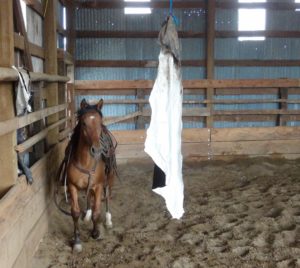 A friend asked for some help with a horse that was afraid of plastic. The horse was OK with the plastic everywhere but around his head. “If you get it up there, he will panic and run”, my friend told me.
A friend asked for some help with a horse that was afraid of plastic. The horse was OK with the plastic everywhere but around his head. “If you get it up there, he will panic and run”, my friend told me.
There is always a place where a horse can handle plastic or a scary object, even if it is 30 feet away. Then, there is the spot where it starts to bother them, and finally there is the place where you cross a line and they panic.
I don’t know why it is so tempting for us to cross that line. I think we want them to overcome the fear and we figure that’s the best way, so we just stick it in there over and over, no matter what they do. Some horses can work through that, but most can’t. There is a better way that all horses can respond to.
Start by isolating the horses’ reactions and attention into four categories.
#1. No Reaction
#2. Tense
#3. Scared but not in a panic
#4. In A Panic
No reaction means the horse simply doesn’t care about the object. He will stand and move around freely in the presence of the object. A tense horse will have his attention on what ever is making him nervous. He may be standing, trotting or loping, but not too fast. A scared horse will be moving faster, blowing and snorting or maybe he will be too afraid to move at all. A panicked horse will be tearing around, bucking, running or on the fight.
Present the object to the horse at the distance that just gets his attention. This is category #2 or ‘Tense’ frame of mind for the horse. In other words, you are exposing the object at a distance or at the place where he can handle it, but it is a challenge. Respond when the horse makes a change (moves more relaxed and or slows down) by easing off the pressure and giving him a break. Even if your horse doesn’t show a change, ease off the pressure every once and awhile anyway so he can relax and then start again. You will stay in categories # 2 and #3 to work the horse through this. Just remember to ease up every once and awhile to give him a rest and time to relax.
You should try to avoid category #4 which is the ‘panicked’ horse. Sometimes, you have to cross the line into Category #4 to know where it is. When you do, back out and remember where the line is so you don’t cross it again. As you stay in categories # 2 and #3, the reaction to the object will become less and less. Your horse will move from being tense or scared to just uncomfortable and then to being comfortable with the object any where around them. You will have eliminated categories #2,3 and 4. When a horse is not reacting, then it can respond. Response is what we want. When the object is no longer an issue, the horse will stand relaxed and move out relaxed when asked.
So, our natural tendency is to go straight into category #4, but when the trainer goes straight to the panic zone, the message to the horse is that his sense of self preservation means nothing, and this destroys trust. Reading our horses and helping them work through things before they are panicked is the better way. This will help them trust us and trust our judgement.

